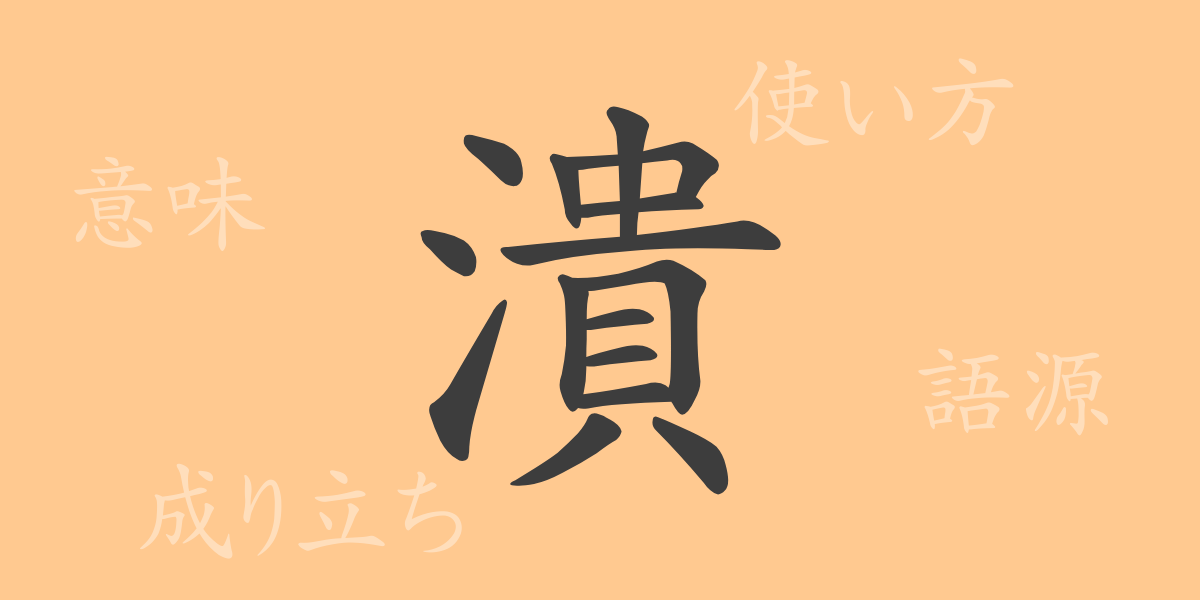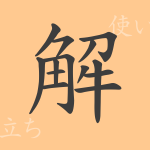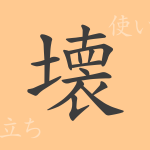The Japanese language has thousands of kanji characters, each with its own unique history and meaning. The commonly used kanji “潰” (Tui) is no exception. In this article, we will explore the origins, meanings, usage, readings, and even phrases and idioms that include “潰” (つい(kui)), delving into the full picture of this character often seen in everyday life. Let’s uncover the story behind this kanji.
The Origins (Etymology) of 潰 (Tui)
The kanji “潰” (Tui)symbolizes the state of something breaking by the water’s edge. Its prototype can be seen in ancient Chinese oracle bone script, composed of the radical for water “水”( Sui) and “会” (Kai), which means to break or destroy. Over time, “会” (Kai) transformed into “𠂇” (a depiction of a person collapsing) and eventually settled into the current form “潰” (つい(kui)). This character expresses the state of something being destroyed from within or liquid leaking out.
Meaning and Usage of 潰 (Tui)
“潰” (Tui) means “to crush” or “to break.” Specifically, it refers to the act of crushing a physical object with force or the failure of an organization or plan to function. Metaphorically, it can also represent the shattering of hopes or dreams. In usage, it appears in phrases like “the company went bankrupt” (会社が潰れる (Kaisya-ga-tubu-reru)or “to crush a spider” (蜘蛛を潰す (Kumo-wot-ubu-su).
Readings, Stroke Count, and Radical of 潰 (Tui)
“潰” (Tui) has multiple readings in Japanese, primarily as follows:
- Readings: The on’yomi (Chinese reading) is “カイ” (Kai), and the kun’yomi (Japanese reading) is “つぶ.す” (つぶす(Tsubusu)) and “つぶ.れる” (つぶれる(Tsubureru)).
- Stroke Count: The total number of strokes for “潰” (Tui) is 15.
- Radical: The radical is “水” (すい(Sui)), but it is often placed as the three-stroke “氵” (さんずい(Sanzui)) on the side.
Phrases, Idioms, and Proverbs Using 潰 (Tui) and Their Meanings
There are numerous phrases, idioms, and proverbs in Japanese that include “潰” (Tui). Here are some examples and their explanations:
- 潰瘍 (Kaiyou): An ulcer, which is a hole that forms when a part of the tissue necrotizes. Commonly used in medical terminology.
- 店を潰す (Mise o tsubusu): To go out of business and close up shop.
- 目を潰す (Me o tsubusu): To damage the eyes so they cannot see, or to lose sight of the essence of something.
- 潰れる夢 (Tsubureru yume): A dream or hope that has become unattainable.
- 時間を潰す (Jikan o tsubusu): To kill time by doing something when one has nothing better to do.
Conclusion on 潰 (Tui)
The kanji “潰” (Tui) encompasses a wide range of meanings in its form and sound. This character, commonly used in everyday life, represents phenomena ranging from the physical destruction of objects to the destruction of more abstract concepts. Furthermore, phrases and idioms containing “潰” (Tui) reflect not only their literal meanings but also cultural backgrounds and people’s emotions. Understanding such profound kanji is essential to deeply appreciate the richness of the Japanese language.

























